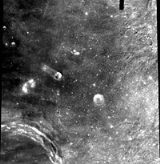
Sinus Lunicus
Encyclopedia
Sinus Lunicus is an area of lunar mare
along the southeast edge of the Mare Imbrium
. It is formed by the area enclosed by the prominent craters Archimedes
to the southwest, Autolycus
to the southeast, and Aristillus
to the northeast. The bay is open to the northwest, and faces the Montes Spitzbergen
, a small chain of mountains.
This bay was named the Bay of Lunik by the International Astronomical Union
(IAU) in 1970 to honor the landing site of the first space probe to make contact with another interplanetary body. The Luna 2
landed in the gap between the craters Archimedes and Autolycus on September 14, 1959.
The official selenographic coordinates
of Sinus Lunicus are 31.8° N and 1.4° W, with a diameter of 126 kilometers. The most distinctive features on the bay are the complex outer ramparts of ejecta from the craters Aristillus and Autolycus, and the small satellite craters Archimedes C and Archimedes D. The albedo
of the surface is brightened by overlapping ray material
from Autolycus and Aristillus.
Lunar mare
The lunar maria are large, dark, basaltic plains on Earth's Moon, formed by ancient volcanic eruptions. They were dubbed maria, Latin for "seas", by early astronomers who mistook them for actual seas. They are less reflective than the "highlands" as a result of their iron-rich compositions, and...
along the southeast edge of the Mare Imbrium
Mare Imbrium
Mare Imbrium, Latin for "Sea of Showers" or "Sea of Rains", is a vast lunar mare filling a basin on Earth's Moon and one of the larger craters in the Solar System. Mare Imbrium was created when lava flooded the giant crater formed when a very large object hit the Moon long ago...
. It is formed by the area enclosed by the prominent craters Archimedes
Archimedes (crater)
Archimedes is a large lunar impact crater on the eastern edges of the Mare Imbrium. To the south of the crater extends the Montes Archimedes mountainous region. On the southeastern rim is the Palus Putredinis flooded plain, containing a system of rilles named the Rimae Archimedes that extend over...
to the southwest, Autolycus
Autolycus (crater)
Autolycus is a lunar impact crater that is located in the southeast part of Mare Imbrium. West of the formation is Archimedes, a formation more than double the size of Autolycus...
to the southeast, and Aristillus
Aristillus (crater)
Aristillus is a prominent lunar impact crater that lies in the eastern Mare Imbrium. Directly to the south is the smaller crater Autolycus, while to the southwest is the large Archimedes. The area of mare to the southwest is named the Sinus Lunicus...
to the northeast. The bay is open to the northwest, and faces the Montes Spitzbergen
Montes Spitzbergen
Montes Spitzbergen is a solitary mountain chain in the eastern Mare Imbrium of the Moon. They are located about a crater diameter to the north of the prominent flooded crater Archimedes....
, a small chain of mountains.
This bay was named the Bay of Lunik by the International Astronomical Union
International Astronomical Union
The International Astronomical Union IAU is a collection of professional astronomers, at the Ph.D. level and beyond, active in professional research and education in astronomy...
(IAU) in 1970 to honor the landing site of the first space probe to make contact with another interplanetary body. The Luna 2
Luna 2
Luna 2 was the second of the Soviet Union's Luna programme spacecraft launched to the Moon. It was the first spacecraft to reach the surface of the Moon...
landed in the gap between the craters Archimedes and Autolycus on September 14, 1959.
The official selenographic coordinates
Selenographic coordinates
Selenographic coordinates are used to refer to locations on the surface of Earth's moon. Any position on the lunar surface can be referenced by specifying two numerical values, which are comparable to the latitude and longitude of Earth...
of Sinus Lunicus are 31.8° N and 1.4° W, with a diameter of 126 kilometers. The most distinctive features on the bay are the complex outer ramparts of ejecta from the craters Aristillus and Autolycus, and the small satellite craters Archimedes C and Archimedes D. The albedo
Albedo
Albedo , or reflection coefficient, is the diffuse reflectivity or reflecting power of a surface. It is defined as the ratio of reflected radiation from the surface to incident radiation upon it...
of the surface is brightened by overlapping ray material
Ray system
A ray system comprises radial streaks of fine ejecta thrown out during the formation of an impact crater, looking a bit like many thin spokes coming from the hub of a wheel. The rays can extend for lengths up to several times the diameter of their originating crater, and are often accompanied by...
from Autolycus and Aristillus.

